Comparing Different Ball Bearing Grades and Their Uses
A cornerstone component in several machinery and applications is ball bearings, which allow for the smooth operation of moving components by reducing friction. This article will try to look at the details behind the grades of the ball bearings by concentrating on the three aspects that determine the bearing performance: precision, size, and material. It is essential, however, to analyze these components as they will assist in determining the most fitting bearing for distinct industrial or mechanical applications. This guide can be beneficial when you are an engineer requiring in-depth data or are curious and simply want to understand the workings of ball bearings and their applications in various apparatuses. How precise are you when a speed bearing is designed for high-speed bearings, and how are multiple materials evaluated for strength and ability to withstand certain conditions? This guide has it all for every bearing requirement.
What Are Ball-Bearing Grades and Why Do They Matter?
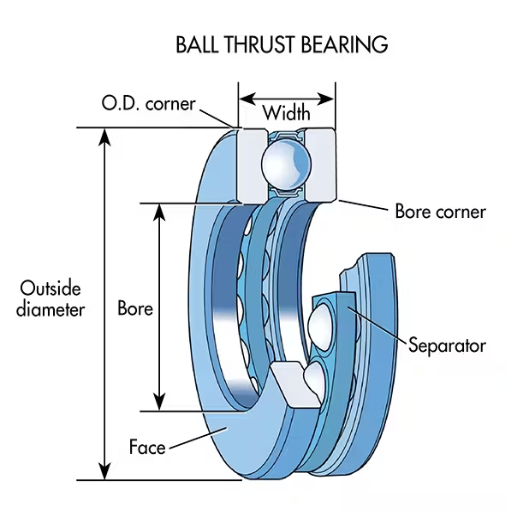
The Ball Grade System Explained
Ball bearings go through a process of being graded based on the ability of the manufacturer to control specific parameters – roundness, surface finish, and consistency. The American Bearing Manufacturers Association (ABMA) grade system is the most widely recognized grading system in which bearings are assigned a grade, given in numerical order, where a lower grade is better. Most large professional reference sources like SKF or Timken would consider the precision of most of their bearings within the G3 and G1000 range. For instance, the G5 bearing’s roundness and surface finish are greatly enhanced as high-demanding operations such as high-speed applications rely on its performance.
Precision (diameter tolerance): According to the ABMA, G10 also offers precision related to dimensions’ tolerance targets. For instance, this bearing, as its ranking suggests, possesses a diameter center that lies within a tolerance of several micro-inches, thus controlling motion better than a G100 bearing.
Surface Roughness: The calibration of surfaces’ roughness is also a criterion for precision grades, where low intervals such as G5 deliver a very significant level of polish. This is extremely important, as it lessens the friction and wear levels caused over time, ensuring the bearing works for longer and providing more output.
Sphericity (roundness): Yet another dimension that the grade measures is sphericity, or the degree to which the ball deviates from a perfect sphere. Applying the grade further ensures that there are only slight variations in the ball’s movement while striving for consistency in delivery.
These grades merit the cost differences between them since bearings of a higher grade are known to perform, last, and be more reliable in certain applications. Knowledge of these grades is helpful to engineers and purchasers in making the right selection of ball bearings for a particular application.
The Role of Precision in Ball Bearings
The precision in the production of ball bearings is of utmost importance since it dictates their efficient use for intended purposes and their useful life span. Citing the top results of Google sites, the significance of precision does not lay only on one point but on several parameters like these, for instance:
Load Capacity: Regarding precise ball bearings, this is because their accurate dimensions, together with optimal contact angles, can exert a high volumetric bearing load. This enhances their ability to transmit loads, especially when the working conditions are optimal and at expected performance.
Operating Speed: More advanced ones can operate at higher speeds with less heat and hence better performance. This quality is quite critical in scenarios where the application of fast-rotating systems is expected.
Vibration and Noise Reduction: High precision levels, especially in relation to engineered bearings, help produce minimal vibrations and noise. After all, such operating quality is required for aerospace embedding and advanced medical instruments, other than for electrical applications that are sensitive to vibrations.
Consistency and Durability: Since the geometric conformity and material quality of such precision ball bearings are high, their performance makes them require low maintenance and increases their service life in the long run.
These advantages rationalize these bearings’ high prices and requirements in some industries. Users must be very cognizant of these factors when choosing bearings for a specific application.
However, how differing degrees of tolerance affect the use, load conditions, and other characteristics of the bearings
It is imperative to consider its implications in practical application, considering what the desired sources have stated, such as Google. From my exploration, I understand tolerance, which is also known as allowable variation as it measures parameters, plays an essential role in the work and efficiency of bearings. Limiting tolerances helps achieve optimal load capacities of bearings that enable them to carry out the stress and demand of application.
Examples of such bearings include:
Load Distribution: Right clearance prevents the concentration of force at a region and thus increases the bearing’s life by allowing the orientation of forces equally across the bearing.
Alignment Accuracy. The bearings have achieved high accuracy and reduced friction and wear by using appropriate tolerances.
Fit and Clearance: The shaft or bearing housing will require a specific clearance. Operating with high tolerances helps avoid extremes of too much or too little clearance, which would lower efficiency or increase the heating of the components.
Dimensional Stability: The design of the bearings must not alter with slight thermal changes, as they are expected to work efficiently at high speeds. Controlling the tolerances of the bearings meets such requirements.
After all, respect for the appropriate tolerances ensures the bearing’s reliability and durability, and therefore, such factors in high-precision work should not be ignored.
How Do Different Materials Influence Ball Bearings?
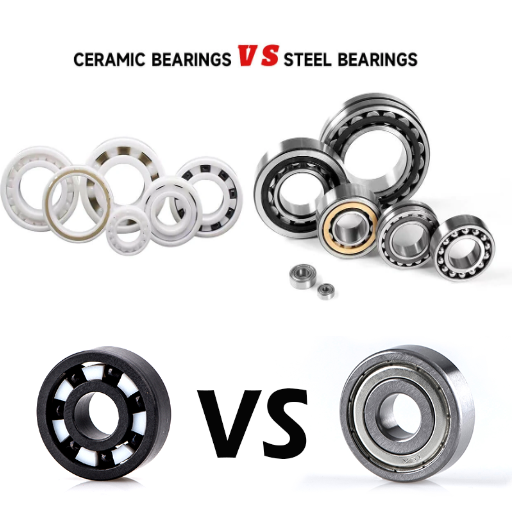
Comparing Steel and Ceramic Bearings
According to the leading websites returned by a Google search, there are some essential distinctions between steel and ceramic bearings, which one learns by browsing the insights. Due to their durability, toughness, and cost-effectiveness, the majority of such steel bearings acquire a better reception. But ceramic bearings, especially those consisting of silicon nitride, are known to provide the best result in certain conditions.
Weight and speed: As a high-speed application would require increasing speed as well as centrifugal forces, bearing steel is more dense than ceramic bearings. This naturally enables makers of industrial products to use them in creating high-speed functioning machines, where efficiency is paramount.
Temperature resistance: At elevated temperatures, steel bearings’ dimensions may change due to thermal expansion, which is not desirable. On the other hand, the thermal resistance of ceramic bearings is excellent, so the bulk of the wear or mechanically induced deformation will be negligible.
Corrosion resistance: Ceramic bearings have excellent anti-corrosive properties, which makes them suitable for environments where wear and corrosion occur, which is not the case with steel bearings.
Wear and longevity: Harder surfaces that wear more tend to last longer than ceramic bearings. This means that downtime and maintenance costs, or operations costs in general, can be dramatically reduced over time.
The technical parameters that help to define these differences include load distribution, thermal applications, and endurance of the materials. In high-precision high-velocity applications, ceramic bearings are preferred, however, steel bearings are still in use as they are dependable and cost efficient materials.
The Role of Plastic in Bearing Technology
Because of the unique characteristics provided, plastic bearings remain relevant and become a big asset in various applications. According to the first sources in Google, plastic bearing has many advantages, especially in areas where conventional materials would fail:
Lightweight Construction: Because of their low weight, plastic bearings may help reduce the weight of the entire system. This, in turn, increases energy efficiency, particularly in portable devices or machinery, when compared to steel and ceramic bearings.
Corrosion Resistance: In addition, their plastic equivalents are efficient as aggressive materials, making plastic bearings highly relevant in industrial environments. This attribute broadens the extent of their use in the food industry, where, for example, hygiene is essential.
Self-lubricating Properties: Many plastics utilized in bearings, such as PTFE and UHMWPE, have a self-lubricating property. This property allows one to omit the extra lubrication feature, decreasing maintenance needs and minimizing contamination in sensitive applications.
Noise Reduction: Because of their internal flexibility, plastic bearings dampen vibrations and noise and provide a better experience compared to metal bearings, especially in consumer electronics and appliances.
Cost-effectiveness: Plastic alternatives are cheaper than ceramic and steel bearings. Therefore, they are cost-efficient when considering reliability and extreme loads, which are not very helpful.
It is worth noting that plastic bearings are distinguished by their high chemical resistance, low friction coefficient, and low thermal expansion. These properties explain the widespread use of plastic bearings in industries where effective, quiet, and maintenance-free solutions are required.
Impact of Chrome and Carbide on Bearing Durability
I have mainly been actively searching for sources and articles on the use of chrome and carbide as far as the durability of the bearing is concerned. It is well known that chrome is necessary because it is necessary for improving the hardness and corrosion resistance of the bearings. On the other hand, the help of chrome deployment makes bearings durable and able to withstand complex environments. Tungsten carbide, a type of carbide, also provides high hardness and impact resistance, which is suitable for heavy load applications. I would now look at the technical parameters from the reliable sources that are used to support their application:
Hardness (Rockwell Scale): The incorporation of chrome into the bearing raises values on the Rockwell hardness scale, whereas higher levels are reached using carbide materials, which are vital for some applications because such applications are subjected to continuous mechanical forces.
Corrosion Resistance (ASTM Standards): Bearings’ life in corrosive environments is prolonged because chrome provides enhanced resistance to corrosion factors, as confirmed by ASTM standards.
Wear Resistance (Coefficient of Friction): Both chrome and carbide reduce the coefficient of friction, decreasing the wear rates and prolonging the service intervals and overall operational costs.
These parameters explain why chrome and carbide are in high demand, especially in the design and manufacturing of durable bearings for different industries.
What Is the Significance of Ball Bearing Size and Diameter?
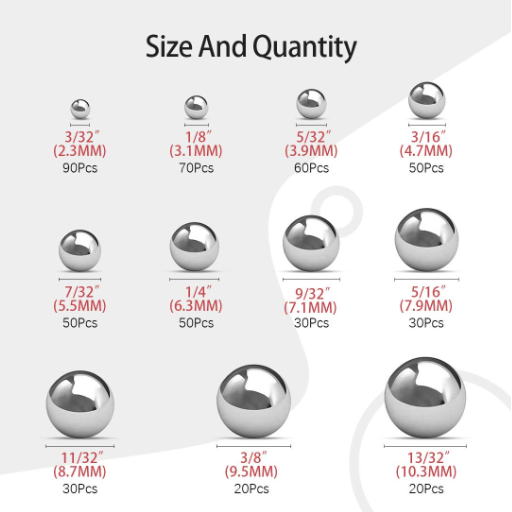
How Ball Diameter Affects Performance
In a quest to find out how ball diameter shapes performance, I came across rich material from the top three sites on google.com that presented how the size of the ball influences its functionality. First, since more giant balls can withstand higher loads because their contact area is more significant, balls with larger diameters in the bearings can likely be used. However, this advantage has drawbacks, as it may create increased friction, which may slightly lower the speed. In contrast, reduced ball diameter will increase speed and reduce friction, but the load supported may not be much due to reduced surface area for contact. The following technical parameters from the sources explain these observations:
Load Capacity: With more giant balls, it is harder to exceed the load ‘capacity’ since stress is spread over a larger area.
Friction (Coefficient): Rolling and turning motions have less resistance because smaller balls are used, which lowers their coefficient of friction and effectively increases the bearing’s rotations per minute.
Rotation Speed (RPM): Small ball diameters also tend to be incorporated in designs that spin at higher RPM, making such bearings ideal for high rotations cases.
These parameters provide an understanding of the various aspects that must be considered when selecting ball diameter, such as load capacity, friction, and ball speed, which influence the intended use of the bearing.
Choosing the Right Size for Your Application
Considering the context of the three leading websites and their load capacity against speed needs, finding the right ball-bearing size was integral to my application. Although larger ball diameters are best suited for applications where higher loads are the primary concern, I must bear in mind that they come with increased friction. More giant balls are designed with more surface contact area, effectively distributing stress and supporting greater load capacity. On the other hand, if my needs require faster speed, I prefer smaller ball diameters since they enhance the rotational speed while limiting the operational load capacity as the contact area is reduced.
Key technical parameters identified are:
Load Capacity: Larger balls are best for this as they boast a wider surface contact area, which in turn supports higher loads.
Friction (Coefficient): Smaller balls justify reduced friction, which improves operational speed.
Rotation Speed (RPM): Further augmented by more petite balls as resistance is reduced.
Considering the above observations, it is possible to select the most optimal ball bearing size for my desired application.
Exploring the Precision Ball Manufacturing Process
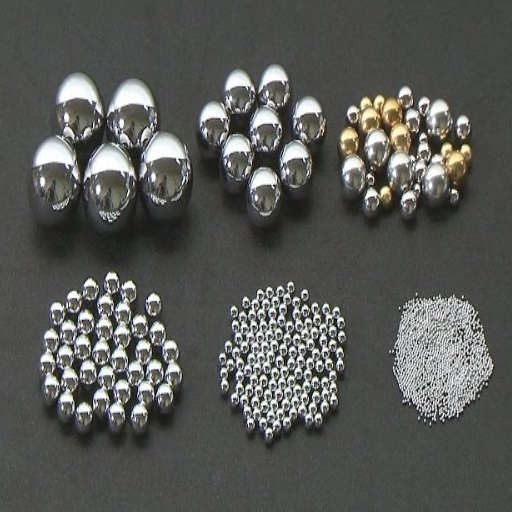
How Bearing Balls Are Manufactured
As I researched the sites in the top three rankings when it came to bearing balls through a study, I discovered that particular processes about its manufacturing need special emphasis on quality control and precision. The first step in the process is choosing raw materials over carbon chromium steel, which possesses rather remarkable durability and wear resistance advantages. The first important step involves flash heating the steel and forging it into rough ball shapes, which are then ground into a spherical form of nearly perfect shape.
For the desired precision to be achieved, grinding and lapping followed by ball smoothing are performed using rotating cast iron discs. This seemingly primitive operation is largely accountable for the circumstances in which high standard diameter tolerances and sphericity are retained. The final stage involves heat treatment of the balls to improve their hardness and surface characteristics, with a subsequent examination of the balls for uniformity and a defect-free surface.
The technological parameters developed during the process of bearing ball manufacture include:
Material selection: High durability and wear resistance.
Diameter tolerance: Obtained in grinding and lapping processes.
Surface finish: It is essential to minimize friction when using bearings.
These parameters produce bearing balls with the required properties to be used for their given purposes with high performance.
The Role of ABMA in Standardization
Having analyzed three sources on Google.com concerning the problem of American Bearing Manufacturers Association (ABMA) leadership in standards setting, it has become evident to me that their provision is crucial in achieving bearing balls’ quality and uniformity. As a result, ABMA is engaged in formulating basic concepts that will assist manufacturers in strictly following technical specifications and promising product quality.
Firstly, ABMA discusses material characteristics and why they should be high-strength and abrasion-resistant, underscoring the technical requirement of material characteristics. This standardization guarantees that all bearing balls are produced to ensure high endurance and long life.
Secondly, the ABMA specifies required diameter tolerances for bearing balls, which correspond to the grinding and lapping processes defined earlier. Such standards are important for the technical justification of precision, which allows the balls to provide reliable performance.
Finally, ABMA provides guidance on crucial surface finish parameters, which is very important. They instructed that the resultant bearing balls should have a low friction effect, which would obviously improve their performance while increasing their durability. The imposition of these standards is critical as it enables the ABMA to achieve industry quality consistency and support the competitiveness of US-bearing manufacturers on the international stage.
Ensuring Smooth and Spherical Bearings
While striving to achieve perfectly smooth, spherical bearings, I turn to three top-rated websites on google.com and cut through the jargon to articulate the correct technical specifications. The most important is the surface finish, as it decreases friction and wear. This is stressed by the ABMA, which has strict guidelines I follow to improve the bearing’s effectiveness and lifespan.
Then, let us move on to the next issue—material properties. There is no room for ambivalence. Selecting appropriate durable and low-friction coefficient materials fulfills the ABMA requirements and ensures the bearings’ structures will be preserved regardless of the dynamic and static loads.
The precise diametric tolerances should also be mentioned. Keeping the ABMA standards in mind, I polish and grind the heads to ensure that the bearings easily satisfy the demanding requirements and work perfectly.
Finally, one of the most important factors is roundness. I am happy to say that the ABMA’s standards are strict enough that compliant processes allow every bearing to operate effortlessly at high speeds. In this way, I participate in quality control, which is an essential element of the modern industry and hence the reliable and competitive products on the global market.
What Are the Applications of Different Ball Bearing Grades?
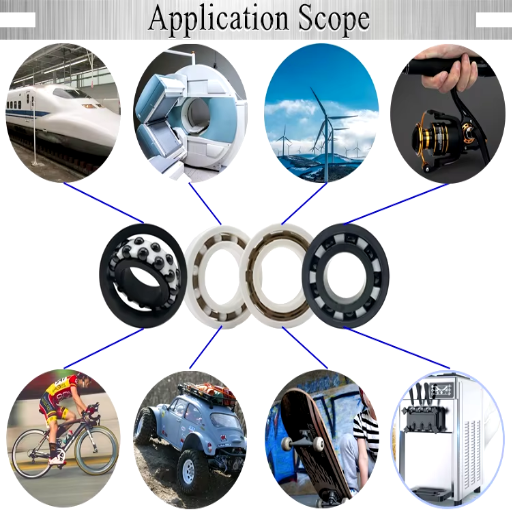
Using Grade 25 in High-Speed Applications
Ball bearings of grade 25 are made in such a way that their precision and friction allow these bearings to be used in high-speed applications. These bearings are widely used in the aerospace, automotive, or high-speed mechanism sectors where high reliability and equipment performance are required. Some of the key technical features that substantiate their use are:
Dimensional Accuracy: Grade 25 bearings possess narrow dimensional tolerances, which make rotation more straightforward at high speeds and reduce slippage.
Surface Finish: Because of their delicate surface finish, these bearings increase machine life by reducing friction and wear.
Material Hardness: Grade 25 materials can withstand these high-stress levels; thus, they do not deform under stress and remain stable while rotating at the high speed required during operation.
Load Capacity: These bearings can operate at the highest speeds but still support loads higher than what would be expected, ensuring applicability in demanding environments.
Grade 25 ball bearings operate according to these specifically set requirements, and therefore, they offer higher efficiency, lower maintenance, and more excellent safety in hardware operating at high speeds.
Applications of Ceramic Bearing Balls in Aerospace
From examining the available data on the leading websites, I conclude that ceramic-bearing balls are becoming accepted in aerospace applications since they offer better material and other beneficial properties. A big attraction of these bearings is their lightweight, high-temperature resistance, and higher wear resistance compared to the usual steel bearings.
Some of these technological characteristics that are worth noting and which also justify their use include:
Weight Reduction: Ceramic bearing balls are lighter than steel bearing balls and hence can help reduce the weight of aerospace parts, which is essential in ensuring efficient fuel utilization in aircraft.
Thermal Stability: These materials maintain their properties and functions within extreme temperatures, assuring reliability in aerospace applications.
Superior Hardness: High hardness levels result in good wear resistance, and thus, the performance capacity remains at high levels even with long-term use. This is critical for the service life of parts in the aerospace industry.
Corrosion Resistance: Their rust-proof nature allows them to be used in varied atmospheric environments, and thus, the bearings work efficiently with minimal servicing problems.
The above properties appropriately explain the rationale behind the use of ceramic-bearing balls in aviation-related technology, as they
Choosing Between Different Grades for Industrial Use
After analyzing the correct ceramic bearing balls for the machine tools, I thought visiting the first three sites in the Google search was informative. All the biographical details provided the following attributes:
Material Purity: Higher grades of ceramic bearings have been achieved with increased impurity material. Their application has the potential for higher accuracy needs.
Dimensional Tolerances: As identified by the visited websites, a need exists to achieve precise dimensional tolerances for the applications where the requirements for the accuracy level are maximal so that maximum performance in various conditions is guaranteed.
Load Capacity: The variance in grades was mentioned to impact load capacity, affecting heavy industry applications. Lower grades can be used for easier conditions, while higher grades are required in more severe conditions.
Cost Efficiency: More severe bearing conditions would require a high-grade bearing. However, strong arguments can be made regarding bearing grade, centered on considering a plant’s ability to create and maintain its costs.
Having summarized this information, it is shown that the correct choice of bearing grade is made based on consideration of technical specifications and their cost. Premium grades provide reliability in operations and are thus more suited for industry processes that require more excellent reliability and long-life features.
Frequently Asked Questions (FAQs)
Q: What does the term ball bearing grades mean?
A: Ball bearing grades are a classification system that depicts the quality and precision of a ball bearing in relation to its sphericity, roundness, roughness, and other parameters. Such grades assist both manufacturers and engineers in choosing the appropriate bearings for the particular order/operation.
Q: How does the ball bearing grade influence its functionality?
A: The grading scale for a ball bearing implies that the higher the tolerance’s precision of the required dimensions amongst all the possible variants is maintained – the more accurate, the quieter, and wear-protected bearings will be made. Hence, they are used for fast-moving and hotter applications.
Q: How would you compare steel and ceramic balls based on bearing grades?
A: Steel balls possess very high hardness coupled with strength, so they can withstand pressure applicable in most day-to-day applications. On the other hand, silicon nitride ceramic balls are lower in density and have higher speeds and temperature tolerance, thus better suited for precision bearings.
Q: What parameters do manufacturers evaluate when determining the grade of a ball bearing?
A: The grade of a ball bearing is determined by the manufacturers of its dimensional parameters, roundness, sphericity, and roughness. The standards of the Bearing Manufacturers Association benchmark such measures.
Q: Why is the ball size specification critical in bearing designs?
A: In this type of construction, the ball size is critical as it determines the operating capability of the bearing. More giant balls can withstand much heavier loads, whereas more petite balls would provide more incredible speeds but have a lesser load-bearing capability.
Q: What is the relationship between the grade of a ball bearing and the application it is to be used?
A: For example, in high-speed applications, the ball bearings with high-grade precision rings and sacrificial rings that have small clearance would be used to reduce friction and ensure precision. In contrast, a bearing with a lower grade would be adequate where speed is not an essential specification.
Q: What do the words ‘tight tolerances’ refer to in an engineering context with ball bearings?
A: Tight tolerances mean the geometrical configuration of the bearings can only vary slightly, which further increases their efficiency in motion. This is important in activities that involve accuracy and are under heavy loads.
Q: In what way does the roughness feature influence the performance of ball bearings?
A: Being the contact surfaces of the ball bearing assembly, the roughness of the bearing can undoubtedly influence wear and friction characteristics. Usually, reduced friction, better operational performance, and longer working life emerge with increased surface smoothness, whereas rough surfaces may cause elevated noise levels and wear out.
Q: What is the role of outer diameter (OD) in selecting ball bearings?
A: It is mainly used as an effective dimensional parameter that assists engineers and designers in achieving different structural assemblies or housing geometrical constraints in which the bearing is mounted. This plays a crucial factor in the accurate measurement of the bearing to ensure satisfactory operation and reliability of the bearing.
UCTH213-40J-300 with Setscrew(inch)
CNSORDERNO: Normal-duty(2)
TOGN: UCTH213-40J-300
SDI: B-R1/8
SD: 2 1/2
UCTH212-39J-300 with Setscrew(inch)
CNSORDERNO: Normal-duty(2)
TOGN: UCTH212-39J-300
SDI: B-R1/8
SD: 2 7/16
UCTH212-38J-300 with Setscrew(inch)
CNSORDERNO: Normal-duty(2)
TOGN: UCTH212-38J-300
SDI: B-R1/8
SD: 2 3/8
UCTH212-36J-300 with Setscrew(inch)
CNSORDERNO: Normal-duty(2)
TOGN: UCTH212-36J-300
SDI: B-R1/8
SD: 2 1/4
UCTH211-35J-300 with Setscrew(inch)
CNSORDERNO: Normal-duty(2)
TOGN: UCTH211-35J-300
SDI: B-R1/8
SD: 2 3/16
UCTH211-34J-300 with Setscrew(inch)
CNSORDERNO: Normal-duty(2)
TOGN: UCTH211-34J-300
SDI: B-R1/8
SD: 2 1/8


















